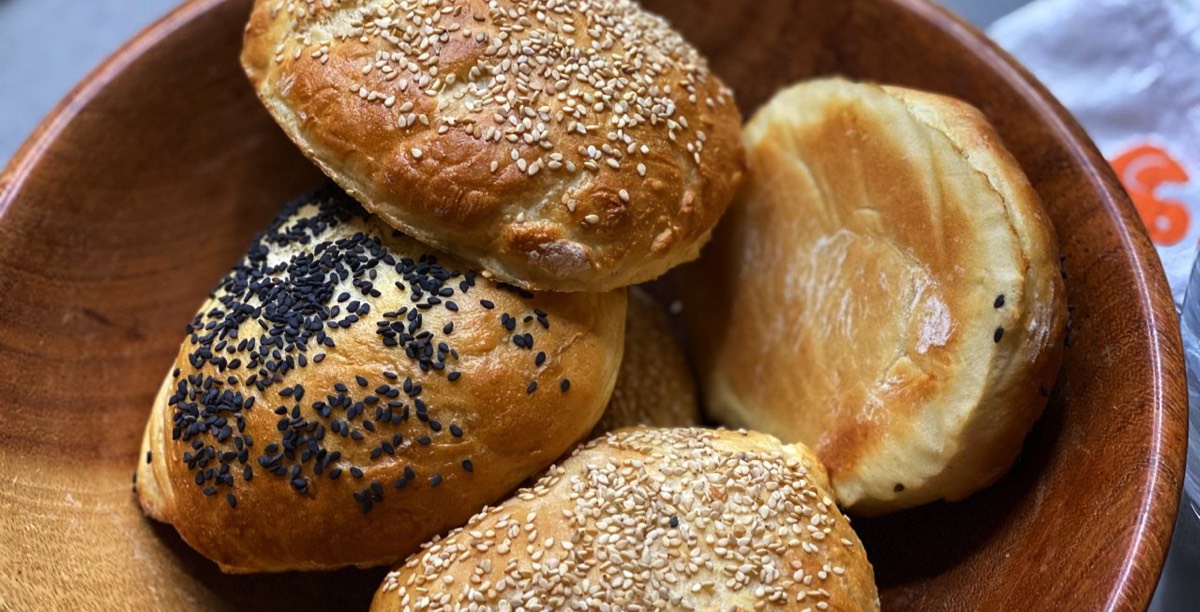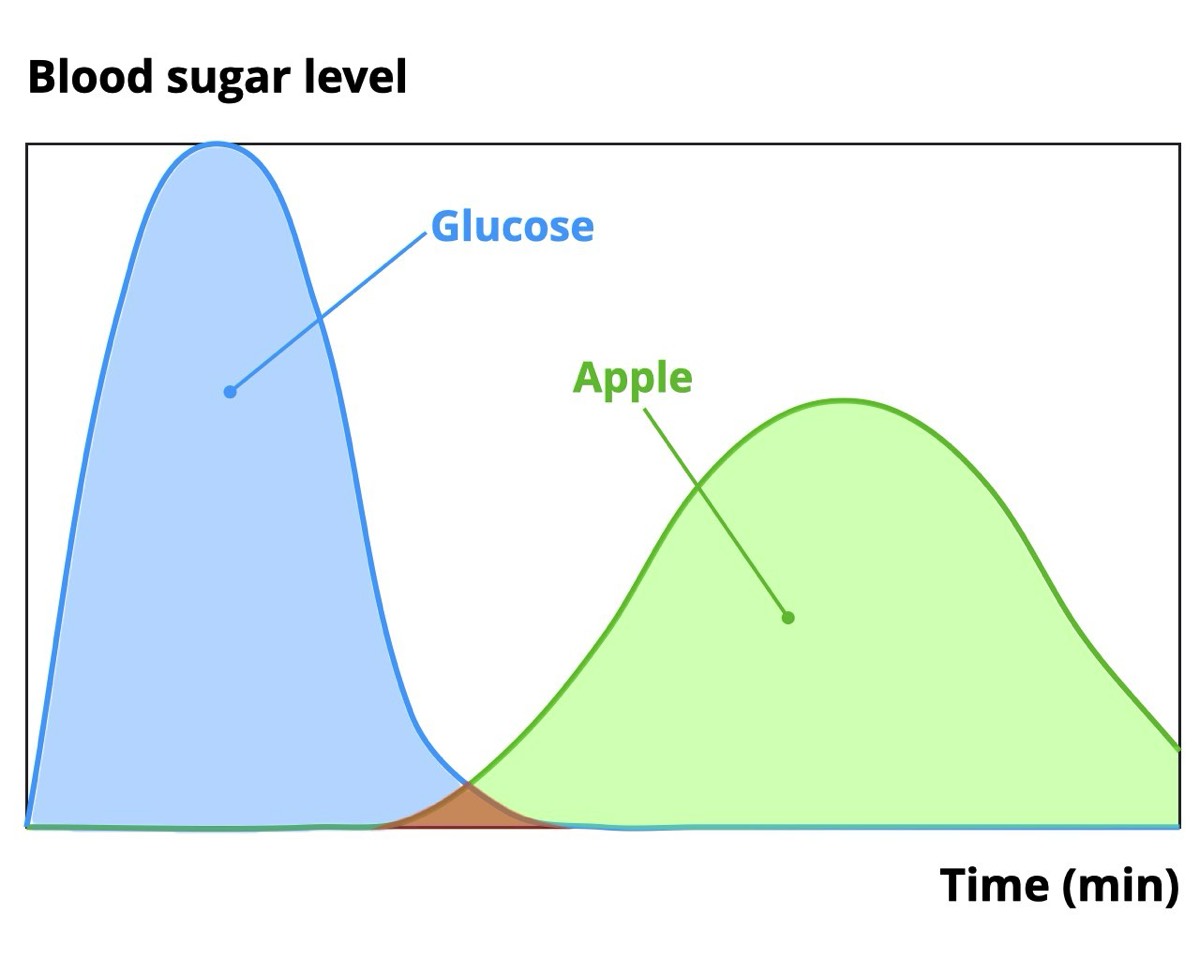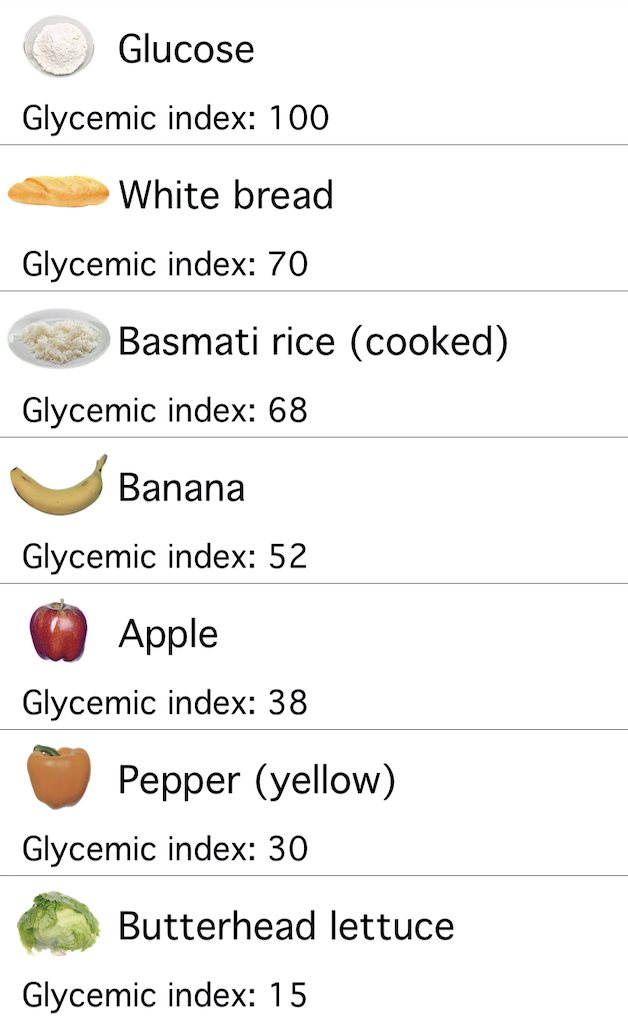What is the glycemic index?

The glycemic index (GI) was developed to measure the influence of carbohydrates on the blood sugar level. It was discovered that different foods cause sugar levels to rise by varying degrees, and that these increases can be measured with a numerical index. The reference value is usually pure glucose (or less frequently white bread), which has a glycemic index of 100. The glycemic index enables you to evaluate the quality of carbohydrates and allows you to identify foods that don't cause large blood sugar spikes.
Determination of the glycemic index
In order to determine the GI, you have to measure the rise of the blood sugar level within two hours of food being consumed. Servings are measured to ensure that they always contain exactly 50 g of carbohydrates. The higher the GI, the higher the rise in blood sugar levels. Figure 1 is a showcase for the blood sugar levels in the two hours after eating glucose and an apple, respectively.

▲Figure 1: Comparison of the rise of the blood sugar level after eating pure glucose and an apple, respectively.
Glucose causes a strong spike of the blood sugar level, followed by a strong decline. An apple on the other hand causes a much slower increase of the blood sugar, because its carbohydrates are released over a longer period of time. That's why an apple keeps you full much longer. Foods with a GI of 50 induce a rise of exactly half of that induced by glucose (GI 100).
Glycemic index of foods
Our app Natural Food Guide knows the glycemic index of over a thousand different foods. You can find a list of select food items from our app in table 1.

▲Table 1: Glycemic index of some common foods, including glucose, white bread, basmati rice, banana, apple, bell pepper and butterhead lettuce.
Glycemic index and diabetes
Foods can be grouped into different categories according to their glycemic index. Foods with a GI of up to 50 have only a moderate effect in raising blood sugar levels. They provide a longer-lasting feeling of saturation and help prevent food cravings. Low glycemic index foods are therefore highly recommended for diabetics.
Foods with a GI of more that 70 cause a strong increase of the blood sugar level, followed by a rapid drop which makes you hungry again very quickly. These foods should be used in small quantities only. Many highly processed foods have a very high glycemic index and are associated, among many other things, with obesity.
Foods with a GI of more that 70 cause a strong increase of the blood sugar level, followed by a rapid drop which makes you hungry again very quickly. These foods should be used in small quantities only. Many highly processed foods have a very high glycemic index and are associated, among many other things, with obesity.
What are the disadvantages of the glycemic index?
The glycemic index has one major disadvantage: It doesn't directly consider the amount of carbohydrates you ingest with one portion. It should therefore be noted that it is difficult to compare foods with strongly varying carbohydrate density. To illustrate: To absorb 50 g of carbohydrates, one would need to consume almost 1 kg of vegetables low in carbohydrates, yet only 100 g of white bread. And it also makes a huge difference whether you eat one slice of bread, or four.
The glycemic load
In order to circumvent this unreliability when using the GI, another factor was incorporated, one that is based on the GI, but which also accounts for the size of serving: the glycemic load (GL).
Example: Pumpkins have a similar glycemic index to white bread, however, the same portion size only contains a fraction of the carbohydrates of bread. Only when you look at the GL you can see that both foods trigger a completely different glycemic response (see table 2).
Example: Pumpkins have a similar glycemic index to white bread, however, the same portion size only contains a fraction of the carbohydrates of bread. Only when you look at the GL you can see that both foods trigger a completely different glycemic response (see table 2).
| Food | Glycemic index | Glycemic load |
|---|---|---|
| White bread | 70 | 27 (high) |
| Pumpkin | 75 | 3,3 (low) |
▲Table 2: Comparison of the glycemic index and load of white bread and pumpkin.
The glycemic load is a more precise parameter for the carbohydrate load and therefore well suited for planning your meals.
The following classifications apply:
The following classifications apply:
- GL 0–10: low
- GL 10–20: medium
- GL >20: high
Both the GI and the GL are dependent on the method of food preparation. Carbohydrates in cooked foods are more easily absorbed by the body, meaning that cooked foods generally have a higher carbohydrate value. Fat and fiber, on the other hand, delay the absorption of carbohydrates, which in turn leads to a lower GL.
Overall, the glycemic load is the most helpful indicator for foods that produce a longer feeling of saturation (fullness) and delay the return of hunger. That's why we focus on this value in our app. Foods with a lower GL are very effective at satisfying bouts of ravenous or extreme hunger.
Back to overview
Overall, the glycemic load is the most helpful indicator for foods that produce a longer feeling of saturation (fullness) and delay the return of hunger. That's why we focus on this value in our app. Foods with a lower GL are very effective at satisfying bouts of ravenous or extreme hunger.
Back to overview

